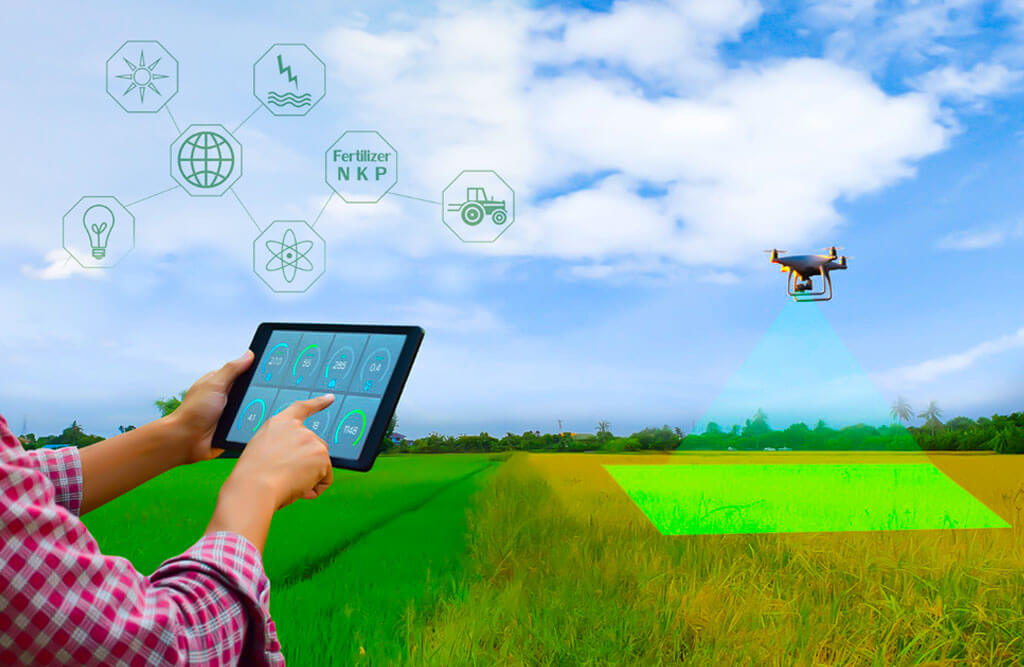
Population is increasing at a great pace, making food security a challenging task. According to the Food and Agriculture Organization of the United Nations (FAO), more than 815 million people are regularly hungry and 64% of these individuals are in Asia. The world needs to increase food production by about 50% to feed a population of nine billion by 2050 AD. At present, the fundamental resources like land and water for agricultural production are decreasing day by day.
Initially, the drone was originated as a military tool and was given different names such as Unmanned Aerial Vehicle (UAV), Miniature Pilotless Aircraft, or Flying Mini Robots. Nowadays it is being utilized in the business sector, infrastructure sector, farming, security, insurance claims, mining, entertainment, telecommunication, and transport sector, etc. The drone has a powerful market opportunity as is evident from the data given in. Such a broad application
of drones has resulted in a very fast improvement in drone technology, thereby making it more user-friendly day by day. Nowadays, the application of small unmanned aerial vehicles (UAVs) is growing at a very fast rate in agribusiness. Drones are semi-automatic devices that are continuously shifting toward fully automatic devices. These devices have an enormous potential for agricultural planning and related spatial information collection.
Historically, ancient agriculture practices were related to the production of food in cultivated lands for the survival of humans and the breeding of animals, and was called the traditional agricultural era 1.0. This mainly resorted to using manpower and animals. Simple tools were used for farming activities, such as sickles and shovels.
The Internet of Things (IoT) is a new technology that allows devices to connect remotely to achieve smart farming. The IoT has begun to influence a vast range of industries, from health, trade, communications, energy and agriculture, to enhance efficiency and performance across all markets.
Current applications provide information on the IoT’s effects, and its practices that are yet to be observed. However, by considering the advancement of technologies, one can envisage the IoT technologies perform a crucial role in numerous activities of farming, such as the utilization of communication infrastructure, data acquisition, smart objects, sensors, mobile devices, cloud-based intelligent information, decision-making, and the automation of agricultural operations.
The adoption of new methods based on sensor and IoT technologies has led to significant improvements in farmers' crop productivity, surpassing traditional agricultural processes. The integration of innovative sensor-based technologies in controlled environments plays a crucial role in enhancing the quality and quantity of agricultural produce.
Greenhouse Agriculture and Secure Production:
Smart greenhouse agriculture has assisted farmers in performing cleanliness tasks without physical intervention, ensuring the protection of plants from wildlife and microbial attacks. The use of sensors measuring essential factors such as temperature, light, and air humidity at night has been crucial for timely interventions in hibiscus plants.
Hydroponics: Hydroponics, a branch of hydroculture, aims to improve soil-less cultivation for the benefit of greenhouse agriculture. Hydroponic-based irrigation systems permit the application of balanced rates of dissolved nutrients, as determined by policy in nutrient-rich solutions.
Controlled Environments : Controlled environments, the inclusion of new and appropriate sensor-based technologies plays a crucial role in improving the quality and quantity of agricultural produce. The integration of new sensor-based technologies in controlled environments is playing a vital role in increasing the quality and quantity of product.
Smart greenhouse farming has assisted farmers in performing cleanliness tasks without physical intervention, ensuring the protection of plants from wildlife and microbial attacks. The use of sensors measuring essential factors such as temperature, light, and air humidity at night has been crucial for timely interventions in hibiscus plants.
Helicopters: It has a single set of horizontally rotating blades attached with a central mast for producing lift and
Thrust. This type of UAV is shown in. A helicopter is capable of vertically take off and land, fly forward, fly backward, and hover at a particular place. These features allow the use of helicopters in congested and remote areas where fixed wing aircraft are unable to operate. Multi-copters: Rotorcraft with multiple sets of horizontally rotating blades (typically 4–8) has the capability to provide lift and control movements of UAV as shown in.
Crop health monitoring : Daily monitoring of crops is performed by the farmers to detect any potential threats such as diseases, pests, and slow rate of growth. The traditional methods for monitoring crops were visual inspection and collecting ground samples manually from random locations. Drones in the agricultural sector are mainly used for field mapping and crop monitoring, shown in. Investigation and analysis of UAV application for crop monitoring has been carried out in this section. Drones in the agriculture field perform many activities that help in monitoring crop health and assist to take corrective actions and thus prevents the spoiling of crops.
Pesticide spraying : This section is about research and developments in UAV-based pesticide spraying systems. Till date, mostly conventional methods for pesticides application are being used in various parts of the world. The manual mechanical sprayer is the most common tool for conventional pesticide application. Manual spraying of the pesticides affects human beings and may lead to diseases like cancer, hypersensitivity, asthma, and other disorders. Additionally, conventional methods have several other shortcomings such as extra chemicals use, farm labor shortage, lower spray uniformity, environmental pollution, and less area coverage.
Conclusions and future challenges : This research paper presents the state-of-the-art development of drone technology for precision farming. The Paper covers two main fields of drone applications in the area of Precision agriculture: crop monitoring, and pesticide spraying. In particular, change in drone structures, development of sensors for data collection, innovation in pesticide spraying drone, implementation of deep learning, and AI in remote monitoring of crops has been addressed. It has been concluded that there is a ramp in drone application for precision agriculture after 2017.